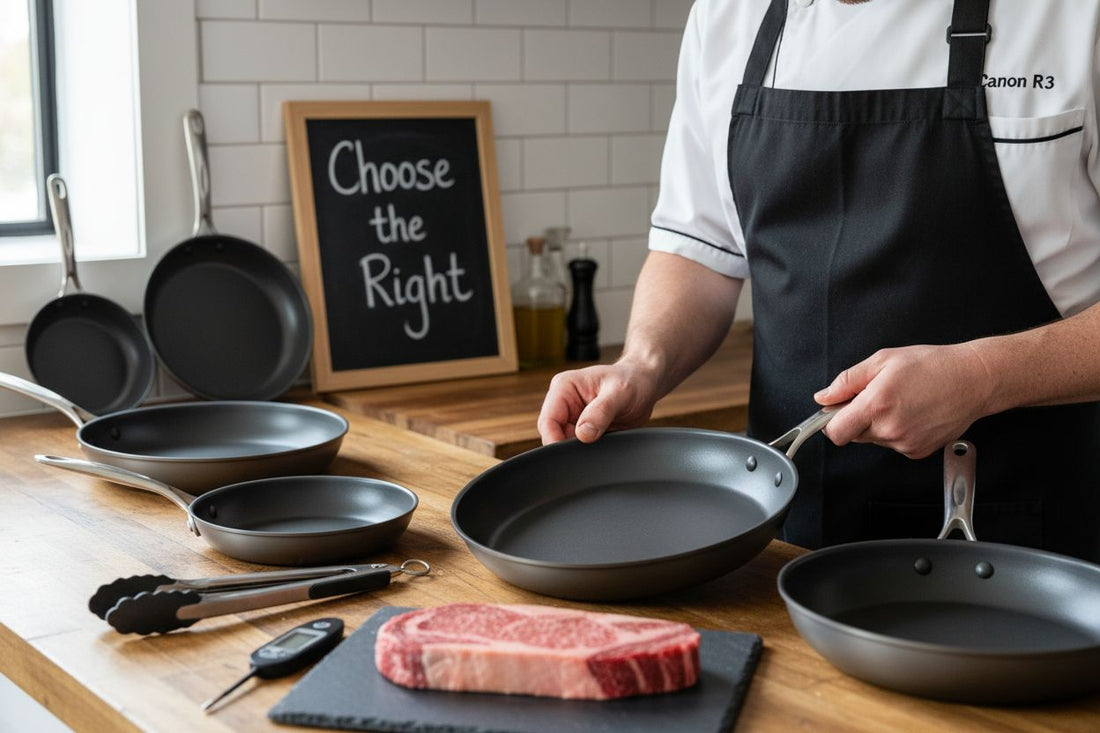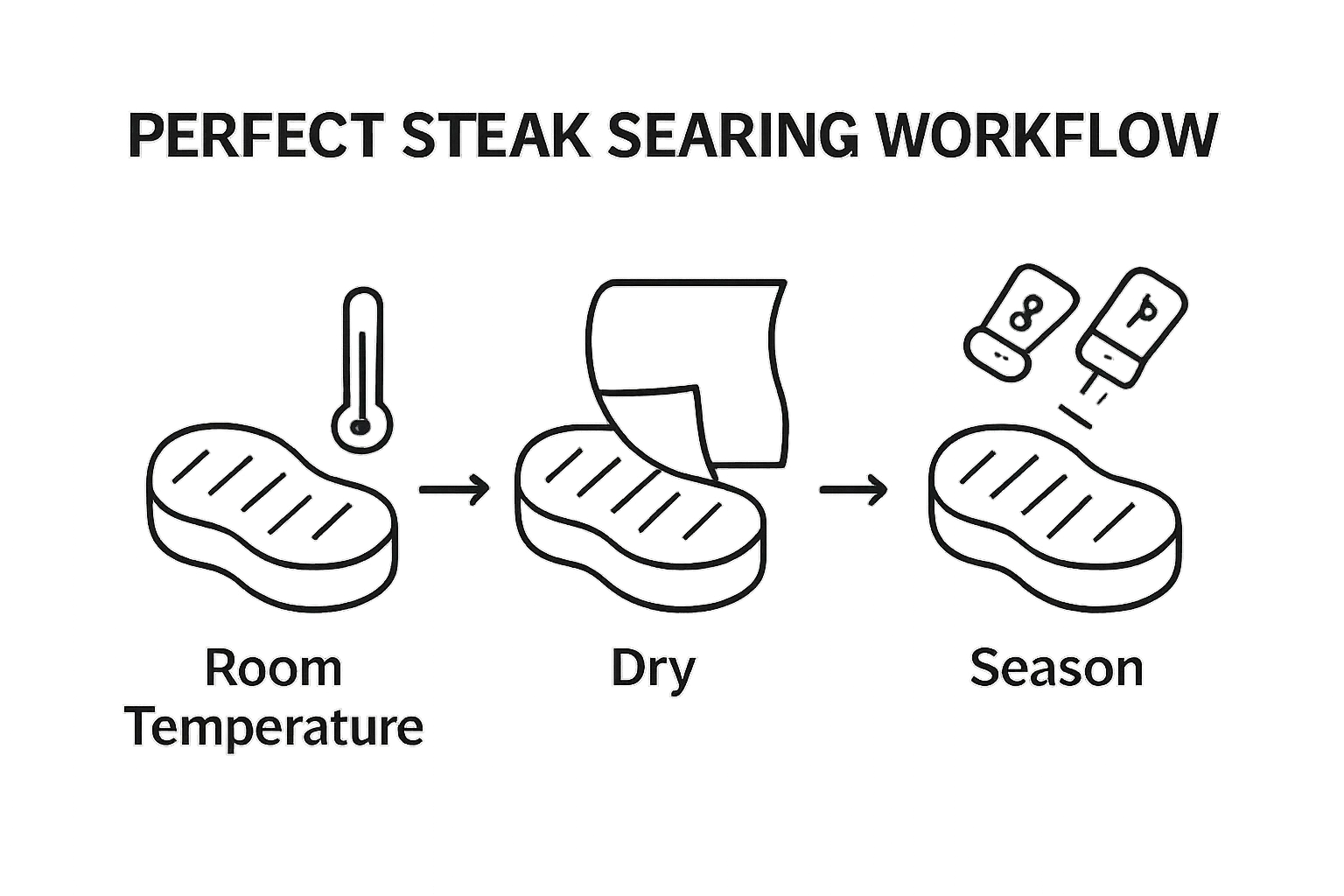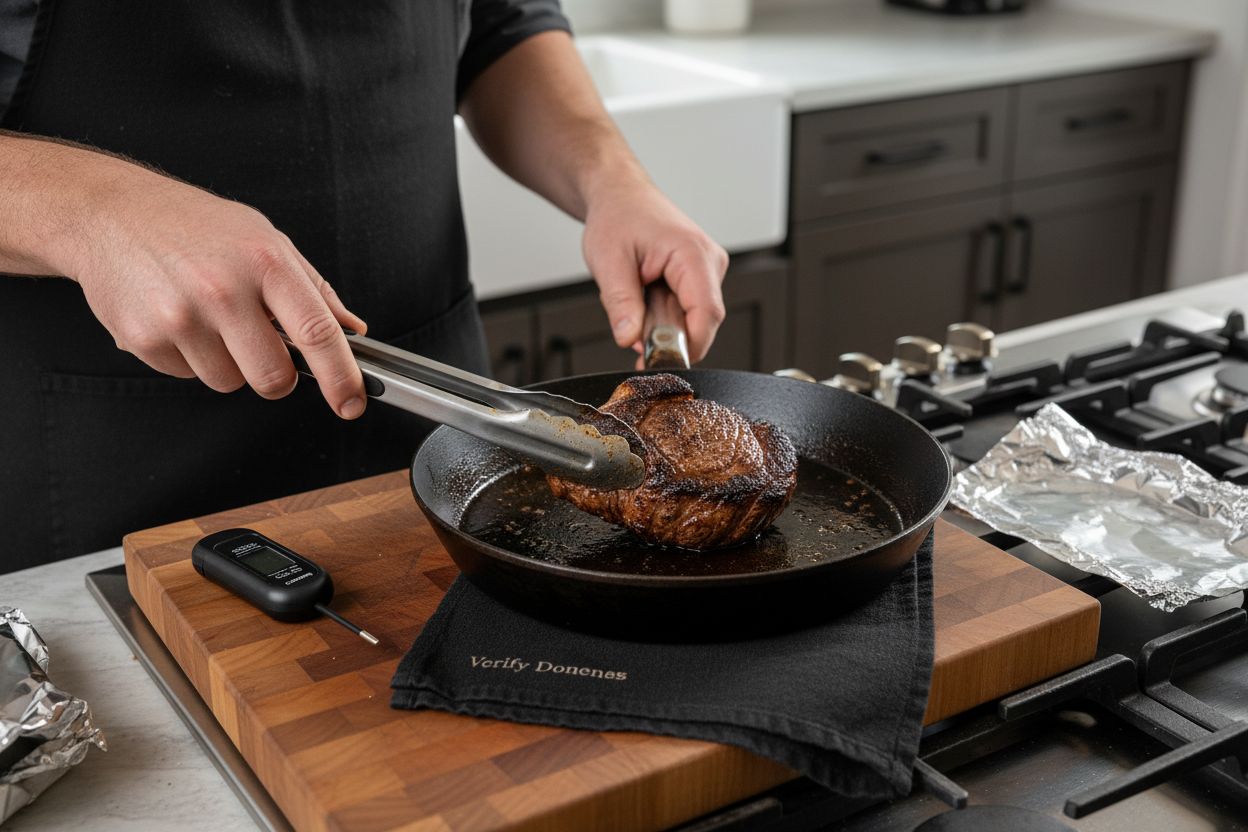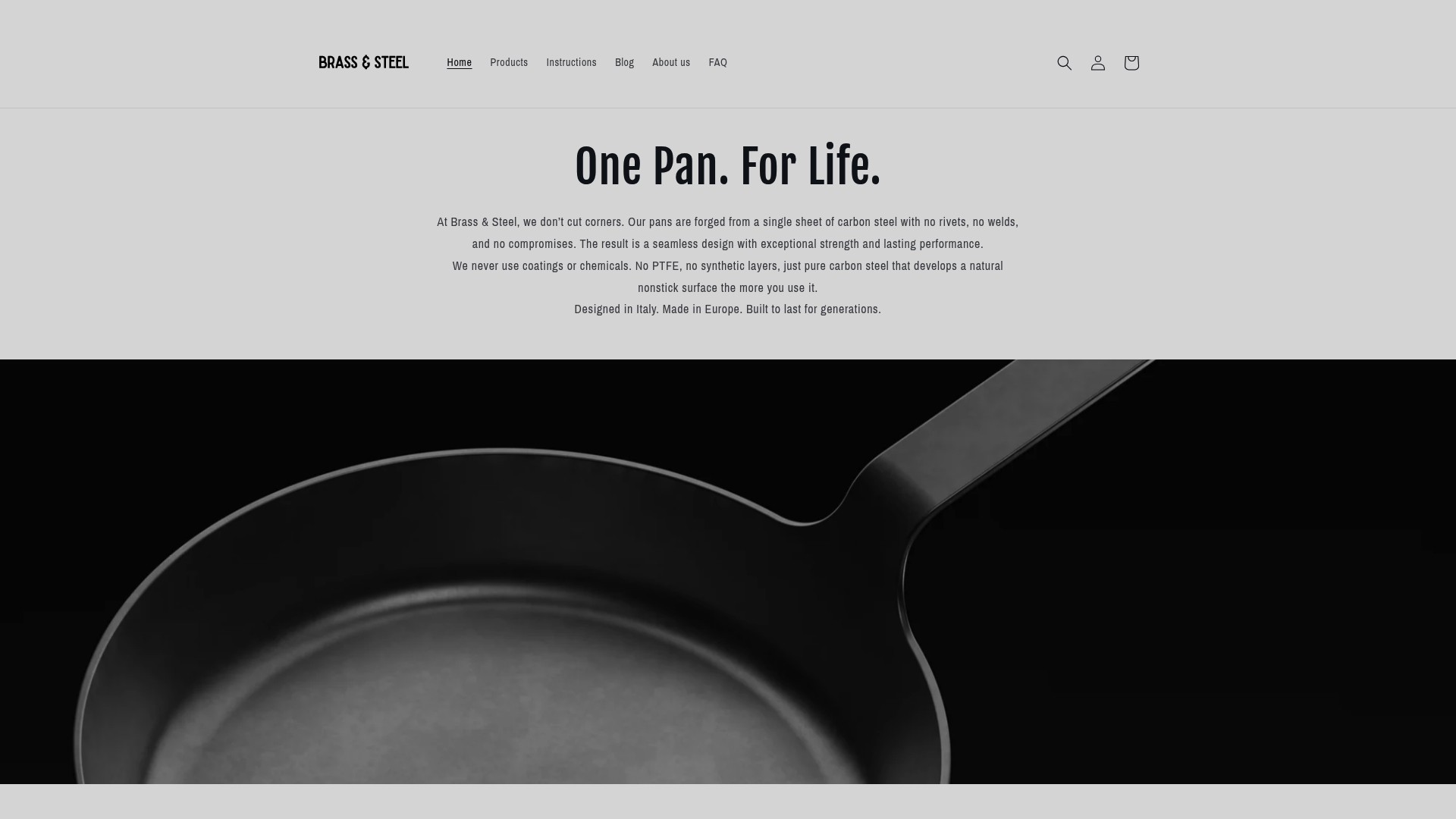
Master the Carbon Steel Pan for Perfect Steak Searing
Share
A perfectly seared steak is every food lover’s dream, but achieving that golden brown crust at home feels almost impossible without the right tools. Surprisingly, it is not all about fancy gadgets or secret chef tricks. It all starts with a carbon steel pan and the science behind its searing power, like how pans between 3mm and 4mm thick hold heat for the best crust. The real surprise? Most people overlook simple steps—such as correct seasoning and preheating—that make the difference between a dry disappointment and a mouthwatering, restaurant-quality steak.
Table of Contents
- Step 1: Choose The Right Carbon Steel Pan
- Step 2: Season Your Carbon Steel Pan
- Step 3: Prepare Your Steak For Searing
- Step 4: Preheat The Pan Appropriately
- Step 5: Sear The Steak To Perfection
- Step 6: Verify Doneness And Rest The Steak
Quick Summary
| Key Point | Explanation |
|---|---|
| 1. Choose a thick, seamless pan | Select a carbon steel pan between 3mm and 4mm thick, forged from a single piece of steel for optimal heat retention. |
| 2. Properly season your pan | Use high smoke point oils and apply extremely thin layers to create a durable nonstick surface and prevent rust. |
| 3. Bring steak to room temperature | Remove steak from the fridge 30-45 minutes prior to cooking for even cooking and optimal sear. |
| 4. Preheat pan to medium-high heat | Gradually heat the pan until water drops skitter across the surface, indicating a suitable searing temperature. |
| 5. Rest the steak after cooking | Allow the steak to rest on a cutting board for 5-7 minutes to retain juices and enhance tenderness before serving. |
Step 1: Choose the Right Carbon Steel Pan
Selecting the perfect carbon steel pan is fundamental to achieving an exceptional steak sear. Not all carbon steel pans are created equal, and understanding the nuanced characteristics that make a pan ideal for steak preparation will elevate your cooking game significantly.
When choosing your carbon steel pan, thickness and construction matter immensely. A pan between 3mm and 4mm thick provides optimal heat retention and even distribution. Pans forged from a single piece of steel eliminate weak points like rivets or welds, creating a seamless cooking surface that transfers heat uniformly. Learn more about choosing the right carbon steel pan to understand the key attributes that separate exceptional cookware from average kitchen tools.
Size plays a crucial role in steak searing success. A pan between 27 and 30 cm offers sufficient space to sear steaks without overcrowding, which can lead to steaming instead of proper caramelisation. The weight of the pan also contributes to its performance. A pan around 2 to 3 kg provides enough mass to maintain consistent temperature during cooking, allowing you to achieve that coveted golden brown crust.
Before purchasing, inspect the pan’s surface carefully. A well-crafted carbon steel pan should have a smooth, slightly textured surface that will develop a natural nonstick patina over time. Avoid pans with significant surface imperfections or uneven manufacturing, as these can impact your cooking results. By investing in a high quality carbon steel pan with these characteristics, you set the foundation for restaurant quality steak searing right in your own kitchen.
Step 2: Season Your Carbon Steel Pan
Seasoning your carbon steel pan is a crucial step that transforms a bare metal surface into a naturally nonstick cooking marvel. This process creates a protective layer that prevents rust, enhances cooking performance, and develops a beautiful patina that improves with each use. Explore our comprehensive guide on seasoning carbon steel pans to understand the nuanced art of pan preparation.
Choose the right oil for seasoning is paramount to success. High smoke point oils like grapeseed, avocado, or refined sunflower oil work best. These oils polymerise at high temperatures, creating a durable protective coating that bonds directly to the pan’s surface. Avoid olive oil or animal fats, which can become sticky and rancid quickly.
The seasoning process requires precision and patience. Begin by thoroughly washing your new pan with warm water and mild soap to remove any manufacturing residues. Dry the pan completely using a clean cloth or paper towel, ensuring no moisture remains. Preheat your oven to 250°C, a temperature that allows the oil to bond effectively with the metal surface. Apply a extremely thin, almost invisible layer of oil using a clean cloth or paper towel. The key is minimal oil coverage - the pan should look almost dry, not glossy or wet.
Place the pan upside down in the oven, with a baking sheet on the lower rack to catch any potential oil drips. Bake for approximately 30 minutes, then turn off the oven and allow the pan to cool naturally inside. Repeat this process two to three times to build a robust initial seasoning. Your pan is properly seasoned when it develops a dark, smooth surface that looks slightly bronze or black.
A successful seasoning means your pan will release food easily and resist rust, setting the stage for perfect steak searing in the next steps of your culinary journey.
Step 3: Prepare Your Steak for Searing
Preparing your steak correctly is just as critical as selecting the right pan. The goal is to create optimal conditions for a perfect sear that locks in flavour and produces a stunning golden brown crust. Discover expert techniques for searing in a carbon steel pan to elevate your cooking skills.
Temperature is the secret weapon in steak preparation. Remove your steak from the refrigerator 30 to 45 minutes before cooking, allowing it to reach room temperature. This crucial step ensures even cooking and prevents the meat from becoming tough and uneven. While the steak rests, pat it thoroughly dry with paper towels. Moisture is the enemy of a perfect sear, so removing surface humidity helps achieve that desirable crisp exterior.
Seasoning should be simple and strategic. Use coarse sea salt and freshly ground black pepper applied generously just before cooking. Avoid salting too early, which can draw out moisture and potentially cure the meat. A light coating of high smoke point oil like grapeseed or avocado oil can help conduct heat and promote even browning. Choose steaks with good marbling - those beautiful intramuscular fat lines that melt during cooking and create incredible flavour. Ribeye, sirloin, and New York strip are excellent choices for carbon steel pan searing.
Before cooking, ensure your mise en place is ready. Have tongs, a meat thermometer, and a small bowl of butter nearby.
Below is a summary table of recommended tools and materials for searing steak in a carbon steel pan, including their purpose and specification.
| Tool/Material | Specification/Type | Purpose |
|---|---|---|
| Carbon steel pan | 3mm-4mm thickness, single-piece | Searing, even heat retention, golden crust |
| High smoke point oil | Grapeseed, avocado, or refined sunflower | For seasoning the pan and oiling steak prior to searing |
| Tongs | Sturdy, heat-resistant | Flipping steak safely |
| Meat thermometer | Digital, instant-read | Checking internal doneness of steak |
| Paper towels/cloth | Lint-free | Drying steak, applying/removing excess oil |
| Coarse sea salt | Fresh | Seasoning steak |
| Black pepper | Freshly ground | Seasoning steak |
| Butter | Unsalted | For basting during searing |
| Thyme and garlic | Fresh | Aromatics for flavour when basting |
 Your carbon steel pan should be preheated to the right temperature, waiting to transform your carefully prepared steak into a culinary masterpiece. By following these preparation steps, you create the foundation for a restaurant quality steak that will impress even the most discerning palate.
Your carbon steel pan should be preheated to the right temperature, waiting to transform your carefully prepared steak into a culinary masterpiece. By following these preparation steps, you create the foundation for a restaurant quality steak that will impress even the most discerning palate.
Step 4: Preheat the Pan Appropriately
Preheating your carbon steel pan is a critical step that separates amateur cooks from professional chefs. The goal is to create an even, intense heat that will deliver that coveted golden brown crust on your steak. Learn advanced carbon steel pan techniques to master your cooking skills.
Medium high heat is your sweet spot when preheating a carbon steel pan. Start by placing your pan on the stovetop and setting the heat to medium high. Allow the pan to heat gradually for approximately 3 to 4 minutes. This slow approach prevents warping and ensures uniform heat distribution. Your pan is ready when a drop of water dances and immediately evaporates upon contact, creating small beads that skitter across the surface. This phenomenon, known as the Leidenfrost effect, signals that your pan has reached the perfect searing temperature.
Pay close attention to your pan’s appearance during preheating. A properly heated carbon steel pan will develop a subtle sheen, indicating it’s primed for cooking. Avoid turning the heat to maximum, which can create uneven hot spots and potentially damage your pan’s seasoning. If you notice any smoking before the water test, reduce the heat slightly. The goal is a consistent, controlled temperature that will create a beautiful crust without burning the exterior of your steak.
Use these moments of preheating to prepare your final cooking tools. Have your tongs, butter, and any additional seasonings within reach. A well prepared cooking station ensures you can move quickly and confidently once the steak hits the pan. By mastering the preheating technique, you transform a simple cooking implement into a precision instrument capable of restaurant quality results.
Step 5: Sear the Steak to Perfection
Searing a steak in a carbon steel pan is an art form that transforms a good piece of meat into an extraordinary culinary experience. Master the techniques for cooking steak in a carbon steel pan to elevate your cooking skills to professional levels.
Placement is paramount when introducing the steak to your preheated pan. Gently lay the steak away from you to prevent any potential oil splatter. Allow the steak to cook undisturbed for 3 to 4 minutes, developing a rich, golden brown crust. This uninterrupted contact creates the Maillard reaction, a complex chemical process that generates those deep, complex flavours professional chefs prize. Resist the urge to move or flip the steak prematurely.
As the first side sears, prepare for the butter basting technique. Once the first side has developed a deep golden crust, flip the steak using tongs. Immediately add a knob of unsalted butter, fresh thyme, and a crushed garlic clove to the pan. Tilt the pan and continuously baste the steak with the aromatic, browning butter. This method not only adds flavour but helps cook the steak more evenly. For a medium rare finish, aim for an internal temperature of 54 to 57 degrees Celsius. Use a meat thermometer inserted into the thickest part of the steak to check doneness.
The final moments of cooking are critical. Remove the steak from the pan and let it rest on a cutting board for 5 to 7 minutes. This resting period allows the juices to redistribute, ensuring a moist and tender result. Your perfectly seared steak should have a deep mahogany crust, revealing a succulent, pink interior when sliced. By following these precise steps, you transform a simple piece of meat into a restaurant quality masterpiece.
Step 6: Verify Doneness and Rest the Steak
The final stage of steak preparation is as crucial as the searing process itself. Explore professional techniques for perfect steak cooking to elevate your culinary skills and understand the nuances of meat preparation.
Temperature is the definitive indicator of doneness. A digital instant read meat thermometer provides the most accurate method for checking your steak’s internal temperature. For medium rare, aim for 54 to 57 degrees Celsius. Insert the thermometer into the thickest part of the steak, avoiding contact with fat or bone. Different cuts and thicknesses will require slight variations in cooking time, so the thermometer becomes your most reliable tool. If you prefer visual cues, a medium rare steak will have a warm pink centre with a rich brown exterior.
Resting is not optional but essential for meat quality. Transfer the steak to a cutting board and let it rest for 5 to 7 minutes. During this time, the muscle fibres relax and redistribute internal juices, ensuring a tender and moist eating experience. Cover the steak loosely with aluminium foil to retain heat without creating steam that could soften the beautiful crust you have developed. Avoid cutting into the steak immediately, which would cause precious juices to escape onto the plate instead of remaining within the meat.
Before serving, consider a final flourish. A small pat of herb butter melted over the rested steak can add a luxurious finish. Slice the steak against the grain to maximise tenderness, creating thick or thin slices depending on your preference. Your carbon steel pan has transformed a simple piece of meat into a restaurant quality dish through precise temperature control, expert searing technique, and patient resting.
The table below provides an overview of each step involved in mastering steak searing with a carbon steel pan, including the main action, estimated time, and expected result.
| Step | Main Action | Estimated Time | Expected Result |
|---|---|---|---|
| Choose the right pan | Select appropriate pan characteristics | 5 minutes | Even heat, flawless crust |
| Season your pan | Apply thin oil layers, bake for seasoning | 1.5 to 2 hours (incl. cooling) | Durable, nonstick, rust-resistant surface |
| Prepare steak | Dry, season, bring to room temperature | 30–45 minutes | Even cooking and optimal sear |
| Preheat pan | Heat to medium-high, test with water drop | 3–4 minutes | Controlled searing temperature |
| Sear the steak | Sear undisturbed, flip, baste with butter | 8–10 minutes | Golden brown crust, Maillard reaction |
| Verify doneness and rest | Check temperature, allow steak to rest | 5–7 minutes (resting) | Juicy, tender steak with properly redistributed juices |

Ready to Achieve the Perfect Steak Sear?
You have followed the expert steps for selecting, seasoning, and mastering your carbon steel pan. Yet, many still struggle with uneven heat, disappointing crusts, or cookware that simply does not measure up. If your goal is truly restaurant-quality results at home, why settle for less than the best? Our Carbon Steel Collection delivers everything the article champions, from single-piece durability and responsive heat to a natural nonstick surface that grows better with each use. These are pans designed for dedicated cooks who demand absolute precision and performance.

Take your next step towards steak perfection. Discover why serious home chefs and professionals alike trust Brass & Steel. Visit our main site for the full range of transformative carbon steel cookware and proven care tips. Make your kitchen ready for unforgettable meals and bring home an heirloom pan today.
Frequently Asked Questions
What is the ideal thickness for a carbon steel pan when searing steak?
A carbon steel pan should be between 3mm and 4mm thick for optimal heat retention and even distribution, ensuring a perfect sear.
How do I properly season my carbon steel pan for steak searing?
To season your pan, use a high smoke point oil, clean the pan thoroughly, apply a thin layer of oil, and bake it upside down in the oven at 250°C for about 30 minutes. Repeat this process for better seasoning.
What cut of steak is best for searing in a carbon steel pan?
Steaks with good marbling, such as ribeye, sirloin, and New York strip, are excellent choices, as they yield incredible flavour when seared in a carbon steel pan.
How can I tell when my steak is cooked to medium rare?
For medium rare, aim for an internal temperature of 54 to 57 degrees Celsius, and use a digital instant-read meat thermometer for the most accurate measurement.
Recommended
- How to Cook Steak in a Carbon Steel Pan: Perfect Every Time – Brass & Steel
- Mastering the Perfect Sear with a Carbon Steel Pan for Steak, Chicken – Brass & Steel
- Carbon Steel vs Cast Iron Showdown: The Best Pan for a Mighty Steak – Brass & Steel
- Cooking with Carbon Steel Step by Step: Mastering Techniques – Brass & Steel